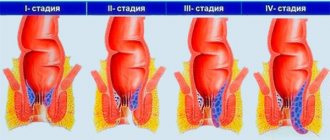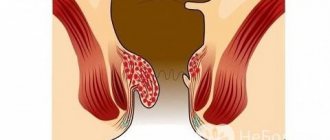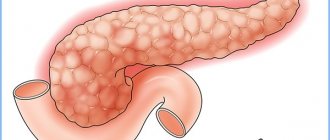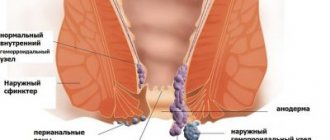Hemorrhoids are a dangerous disease, known to everyone for its complications. In addition to the fact that it can lead to necrosis, pinched hemorrhoids, thrombosis, sepsis, some sources also say that the lack of treatment for hemorrhoidal disease can provoke rectal cancer. Therefore, many patients are seriously concerned about the question - can hemorrhoids turn into cancer? The answer is no, but the diseases are often diagnosed at the same time.
Location of internal hemorrhoids.
The difference between hemorrhoids and rectal cancer
Various diseases of the rectum at a certain stage may have similar symptoms, so it is necessary to correctly differentiate the disease. The article describes the main differences between hemorrhoids and rectal cancer, methods of differential diagnosis in the department of surgery of the university clinic of Moscow State University. M.V. Lomonosov.
- What are hemorrhoids and colorectal cancer?
- Why is it necessary to distinguish between hemorrhoids and rectal cancer?
- How to distinguish hemorrhoids from colorectal cancer
Conclusions and recommendations
Despite the fact that there is no direct connection between hemorrhoids and cancer, the alarming symptoms of the disease cannot be ignored. It is important to combat the disease in a timely and comprehensive manner by reviewing your daily routine and diet with water consumption of up to 2 liters per day. To prevent the occurrence of unpleasant diseases, lead an active lifestyle, eat more vegetables, fruits and engage in light exercise. It is advisable to visit a proctologist at least once every 2 years for preventive purposes.
Read also
Types of hemorrhoids
https://youtu.be/EpoZRCa0abU
Why is it necessary to distinguish between hemorrhoids and rectal cancer?
The most common pathology of the terminal digestive tract is hemorrhoids; approximately 30% of the adult population face this problem. Rectal cancer is much less common, but among colon tumors it is detected in 4 out of 10 cases. An accurate diagnosis is made by specialists after a detailed examination with mandatory histological analysis of the biopsy specimen.
What are the similar manifestations of these diseases:
- discharge of blood during bowel movements;
- frequent urge to defecate;
- feeling of incomplete bowel movement after stool;
- anemia (with severe bleeding).
How to distinguish hemorrhoids from colorectal cancer
You should pay attention to the following features:
- Age. Typically, malignant tumors appear over the age of 50, although in recent decades there has been a trend towards “rejuvenation” of cancer. So young age is not a reason to rule out a cancer diagnosis.
- With cancer, blood can be not only on the surface of the stool; discharge can appear without bowel movements.
- The severity of anemia may not correspond to the amount of blood released (a sharp decrease in hemoglobin levels).
- When cancer occurs, mucus is released from the rectum, in most cases there is more of it than blood.
- The deterioration in general health with hemorrhoidal disease is usually insignificant (if there is no severe blood loss). As the tumor develops, the patient feels severe weakness, fatigue, and possibly a perversion of taste.
- You should pay attention to sudden changes in the usual symptoms of hemorrhoidal disease with a long “experience” of the disease. An increase in the intensity of discharge, the appearance of discharge of an unusual nature, and the addition of new signs may indicate a malignant process.
Markers during medical examination:
- A cancerous tumor can be located both in the anus (low cancers) and deep in the intestine, at a distance of more than 3 cm. Hemorrhoids are located in the anal canal or in close proximity to it.
- A digital examination of a malignant tumor reveals a high-density formation, fused with the surrounding tissues, and limited in displacement. Nodes in hemorrhoids are elastic, movable upon palpation.
- Rectal tumors in advanced stages can significantly narrow the intestinal lumen, up to intestinal obstruction.
- During an endoscopic examination of cancer, ulcerations in the area of the tumor, areas of hemorrhage and changes in the underlying tissues are visually determined.
Ask a Question
Key Features
Characteristics of hemorrhoids
Anxious patients sometimes mistake rectal hemorrhoids for cancer. It is worth understanding what its characteristics and differences are. With hemorrhoids, nodes form around the rectum as a result of disorders that have occurred in the venous apparatus. These nodes can be inside or outside. Venous disease is manifested by dilation, lengthening and tortuosity of the veins. Various factors can provoke hemorrhoids. The following factors primarily influence the development of the disease:
- inactive way of life;
- vascular diseases that have become chronic;
- strong physical activity;
- improper diet;
- chronic constipation.
Hemorrhoids often occur in people who expose the body to constant stress or have pathological processes in the intestines. The hereditary factor is also important. The disease can occur due to physical inactivity, which is characterized by a weakening of muscle activity. Hemorrhoids are not uncommon among office workers who sit most of the time.
Rectal cancer
With rectal cancer, a malignant neoplasm is noted that has arisen in an internal organ. Cancerous formation consists of epithelial tissues. Unlike hemorrhoids, which occur for specific reasons, doctors have not yet been able to fully understand the etiology of cancer. The main sources that provoke intestinal cancer include:
- anal fissures, which irritate the intestinal lining and lead to cell degeneration;
- inflammatory process of the mucous membrane of the anus (proctitis), which, as a rule, is preceded by venous dilatation in the anus;
- a genetic factor in which there were relatives in the family with such an oncological disease;
- excess weight;
- weakened muscle activity;
- regular constipation;
- alcohol and drug abuse;
- constant interaction with toxic agents.
Comparative characteristics of the causes of diseases
Varicose nodes formed as a result of thickening of the walls of venous vessels are called hemorrhoids. The process occurs in the mucous membrane of the rectum, accompanied by discomfort in defecation, constipation and minor bleeding. This disease has no age restrictions, although it is most often observed in men 35-45 years old. Factors that can provoke the disease:
- Sedentary work mode, reduced physical activity.
- Poor nutrition, which results in constipation.
- Hereditary predisposition.
- Physical activity - sports, work associated with lifting weights, when the pelvic floor is often under tension. Pregnancy can be included in this category of causes for the development of hemorrhoids. The growing uterus compresses the pelvic veins, in which “stagnant” areas are formed - the blood flow in these vessels is sharply disrupted. It is in them that the vein stretches, thus forming hemorrhoidal cones.
Cancer is a pathological process of the rectum with the formation of atypical cells of epithelial origin. Just like hemorrhoids, it inflicts its main blow on male patients, although the age group is clearly older - 50 years and above. Rectal cancer becomes malignant over time. Without special treatment, the process progresses rapidly, often with fatal outcome. Many scientists around the world have been struggling for years over the causes of rectal cancer, as well as other organs and tissues, but it is still difficult to definitively establish the etiology of this problem. Just some of the provoking factors are mentioned:
- Nonspecific inflammation of the epithelial cells of the anus - proctitis.
- Anal fissures.
- Constipation associated with eating disorders.
- Excess weight.
- Lack of physical activity.
- Working with carcinogenic substances.
- Intestinal polyposis.
Rectal cancer and hemorrhoids have absolutely identical causes:
- Emotional instability, chronic stress and frequent depression.
- Chronic diseases of any part of the intestine.
- Genetic disposition.
- Bad habits.
Comparison of symptoms of colorectal cancer and hemorrhoids
Is cancer a consequence of hemorrhoids?
Doctors say that hemorrhoids without proper treatment can develop into rectal cancer. This is due to the fact that when the veins dilate, blood circulation in the rectum is disrupted. As a result, nodular formations, growths and expansions occur. If they are not eliminated in a timely manner, they will lead to cancer. Hemorrhoids turn into cancer for the following reasons:
- When normal blood circulation in the rectum is disrupted, this provokes a lack of nutrients, and the deep layers of the tissues of the anus do not receive enough oxygen. At the same time, humoral and cellular immunity is unable to fully perform its functions. The body in this place becomes vulnerable to the effects of free radicals, due to which healthy cells of the internal organ degenerate into malignant ones.
- Due to the inflammatory process that occurs in the veins, a person begins to experience constipation. Residual metabolic products accumulate in the body and poison it. Aggressive substances have a particularly negative effect on digestive tissue. In this case, as a result of constant constipation, an inflammatory process occurs on the surface of the intestine, which is accompanied by necrosis of its tissues. Thus, over time, polyps or tumors of a benign or malignant nature appear in the internal organ.
Return to contents
Cancer and hemorrhoids - what's the difference?
As mentioned above, in the first stages, both of these diseases are extremely difficult to identify without special diagnostics.
A thorough medical history helps a coloproctologist distinguish cancer from hemorrhoids. The survey is carried out taking into account age and gender. The main clues during an oncological interview with a patient are identifying colorectal cancer in the family and performing polypectomy operations - removal of polyps.
Patient complaints will help identify hemorrhoids or cancer.
- Complaints of bleeding from the anus. The nature of the bleeding will help you understand which disease it is - with hemorrhoids, the blood is a normal, scarlet color, and it is noticeable much better than with cancer, when it is more of an impurity or small clots in the stool.
- With hemorrhoids, the act of defecation usually occurs as before the disease; with rectal cancer, tumor decay products may come out before the feces - a mass with an unpleasant odor mixed with blood or pus.
- In case of rectal cancer, feces come out in the form of a ribbon; in case of hemorrhoids, feces have a normal shape.
- Constipation in rectal cancer is protracted; such phenomena are not observed in the clinical picture of hemorrhoids.
- Rectal cancer often occurs with general intoxication of the body.
- With late presentation, the pelvic organs and lower parts of the spinal column may be visible on the images.
Differences between rectal cancer and hemorrhoids?
Main symptoms
Hemorrhoids and cancer in the initial stages are similar, so it is difficult to distinguish them without diagnosis. The symptoms for both diseases are the same, but as the disease progresses they begin to differ. With hemorrhoids, a person may not feel any symptoms for several months or years. There are the following differences between the symptoms of cancer and hemorrhoids:
- Painful sensations with hemorrhoids occur only at the second stage, and the 3rd-4th stage is accompanied by pain not only during the act of defecation, but also during walking and sitting. With cancer, pain occurs at the penultimate stage, when the formation has grown into the intestinal wall, and during metastasis. In this case, pain spreads to the genitals, back and perineum.
- Cancer can also be distinguished from varicose veins by the discharge after bowel movements. Hemorrhoids are characterized by scarlet blood that is found on top of the stool. Cancer is marked by mucous and purulent discharge before bowel movements. Dark blood may be found in the stool. In some cases, small pieces of tumor come out during bowel movements.
- In the case of hemorrhoids, there is usually no change in the stool, unlike cancer. With a malignant formation, the stool becomes thinner and resembles a ribbon. This is due to the narrowing of the intestinal opening.
- Constipation, which can be easily managed in the case of regular hemorrhoids through diet. With cancer, it is impossible to get rid of this symptom so easily. Constipation with a tumor is accompanied by pain in the abdomen and vomiting.
- With cancer, there is a constant false desire to empty the intestines, which is not observed with hemorrhoids.
With cancer, there is a deterioration in the general health of the patient: body temperature rises, weight loss and anemia are noted.
Diagnostics
To distinguish cancer and differentiate the disease from hemorrhoids, the patient should undergo a series of instrumental examinations:
- Colonoscopy using an endoscope to evaluate the condition of the rectum.
- Recomanoscopy, assessing the rectum and colon.
- Histological examinations, in which cells and tissues of the internal organ are taken for analysis.
- Collecting blood from a vein for analysis of tumor markers. The analysis reveals the proteins that the tumor produces.
Return to contents
Treatment
Treatment tactics for cancer always depend on the size of the tumor, its exact location, and the process of metastasis. If the malignant tumor is operable, it is excised along with part of the adjacent tissue. The rest of the therapy is prescribed to reduce the size of the formation and destroy the resulting metastases.
Regardless of whether colon cancer manifests itself or a tumor arises from hemorrhoids, the patient is required to undergo chemotherapy. Drugs used:
- "Erbitux";
- "Avastin";
- "Irinotecan";
- "Eloxatin";
- "Capecitabine".
The regimen, duration and number of courses are prescribed by an oncologist based on the diagnostic data and studies obtained. Radiation therapy helps reduce the size of the tumor, destroy cancer cells and destroy the structure of the tumor. The doctor’s primary task is to apply radiation directly to the affected area of the body, without affecting healthy tissue, so as not to disrupt the functioning of the body.
To protect yourself from the development of cancerous tumors, at the first suspicious symptoms you should immediately seek medical help
To recover, the patient is recommended to take various vitamin complexes and biological supplements, and to relieve pain in the rectal area, painkillers and anti-inflammatory suppositories are recommended. The use of drugs that irritate the rectum is prohibited.
The prognosis of the disease depends on the stage of development when contacting a specialist. In the absence of metastases and the tumor size is less than 1 cm, the patient in 80 percent of cases has a good chance of survival for more than 5 years. Damage to a third of the rectum with no spread of cancer cells throughout the body gives a favorable prognosis in 50 percent of cases. Metastatic forms of cancer are difficult to treat and provide a guarantee only in 10–20 percent of patients.
Prevention
Both of these diseases can cause great harm to health and lead to negative consequences. To prevent this, it is important to take preventative measures. Doctors strongly recommend eating right and eating foods containing fiber and plant fiber every day. It is important to exercise and lead an active lifestyle. When working sedentarily, take breaks for walking or light exercise to avoid stagnation and constipation. People over the age of 40 are recommended to be examined annually by a proctologist.
Hemorrhoids and rectal cancer
Hemorrhoids are inflammation of hemorrhoids with further protrusion or prolapse from the rectum. The disease is accompanied by acute pain and swelling, disrupts bowel movements, and causes physical and mental suffering. Fearing complications, patients ask the question: can hemorrhoids develop into rectal cancer? The symptoms are similar, but the clinical outcome without timely therapy is different.
Hemorrhoids: a brief description of the disease
If painful nodes form in the anus, we are talking about hemorrhoids. If the source of pathology is not stopped within the first 2 weeks after an exacerbation, the pathological process becomes chronic. Hemorrhoids develop against the background of venous insufficiency, when weakened veins cannot cope with the load and lose their natural elasticity. The outflow of blood is disrupted, congestion progresses, and hemorrhoids develop.
Factors causing hemorrhoids:
- passive lifestyle;
- frequent lifting of heavy objects;
- chronic diarrhea/constipation;
- pregnancy, natural childbirth;
- professional sports;
- bad habits;
- congestion in the pelvic organs.
Hemorrhoids are more common in men; patients are young and middle-aged people - 25-35 years old. With hemorrhoids, the following changes in general well-being and patient complaints are observed:
- discomfort, pain during bowel movements;
- itching, burning and irritation of the anus;
- heaviness, sensation of a foreign body in the rectum;
- rectal bleeding;
- blood impurities in stool;
- prolapse of hemorrhoids.
At the initial stage, hemorrhoids are treated with conservative methods; for grades 2 and 3, non-invasive procedures or surgery are performed. A proctologist provides complex therapy for an inflamed hemorrhoid.
Main indicators of the disease
Varicose veins of the rectum are a progressive disease with constant alternation of periods of exacerbations and remissions. Symptoms of the disease increase gradually, and therefore, finding out about the disease at an early stage is extremely problematic. So, let's figure out what signs of the disease may appear in patients. The most common symptoms include:
- blood discharge. In the early stages, this may be light smears on toilet paper, but as the disease progresses, blood loss can be so severe that it leads to the development of anemia;
- soreness. Soreness can be felt at any stage. Typically, at the initial stage, pain occurs during or after defecation and is short-lived. As the disease progresses, pain occurs regardless of going to the toilet and usually manifests itself in the form of attacks that can cover the entire perineum;
- itching and burning. These symptoms arise due to a special secretion that is secreted by the swollen cones. The caustic liquid irritates the skin in the anal area, resulting in the described symptoms;
- nodes falling out. If at the first stage the nodules can be detected only with a special examination, then later the lumps are almost always located outside the rectum. The patient can feel them independently. Typically, the size of the nodes ranges from a few millimeters to a couple of centimeters;
- presence of complications. Complications develop at stages 3-4. These may include suppuration, paroproctitis and fistulas. In addition, the nodes are often pinched by the sphincter muscles.
Rectal cancer: a brief description of the disease
A malignant neoplasm formed from the epithelium of the rectum is called cancer of the specified zone. A malignant tumor is localized in the lumen of the rectal canal or on its walls, and is prone to slow growth and progression. There is a high probability of relapse even after a successful operation.
Determining the cause of malignant degeneration of the epithelium is problematic, but doctors have identified a number of factors that provoke rectal cancer:
- environmental factor;
- poor nutrition;
- ionizing radiation;
- human papillomavirus infection;
- bad habits;
- genetic predisposition;
- occupational hazards;
- diabetes.
At the initial stage of the oncological process in the rectum, the symptoms are similar to those of hemorrhoids. The patient is concerned about:
- acute pain during bowel movements;
- false urge to go to the toilet;
- sudden weight loss;
- slight increase in body temperature;
- sensation of a foreign body in the anus.
With cancer, the symptoms worsen and acquire characteristic differences from inflammation of the hemorrhoid:
- brown blood evenly covering the stool;
- discharge of mucus and pus from the anus in between bowel movements;
- long-term constipation (from 3 days);
- ribbon-shaped stool;
- the malignant tumor does not fall out of the rectum.
To differentiate the oncological process, complex therapy is carried out, which includes sigmoidoscopy, colonoscopy, anoscopy and MRI to visualize the malignant neoplasm and timely detection of progressive metastases. Also, stool with blood discharge is examined in the laboratory.
Can hemorrhoids turn into cancer?
Hemorrhoids cannot transform into oncology, but untreated inflammation of the hemorrhoid creates favorable conditions for the mutation of cells into atypical ones and the formation of a malignant tumor.
Rectal cancer progresses against the background of diffuse polyposis, Crohn's disease, ulcerative colitis, and tumors of the villous epithelium. Doctors do not rule out that a complicated form of hemorrhoids could potentially result in cancer and death for the patient.
Myth 6. Dietary supplements help cure proctological problems
Many people have a strong belief that various dietary supplements help get rid of even such serious problems as anal fissures or hemorrhoids. On the Internet you can find a huge number of recipes for alternative medicine, which claim that hemorrhoids will literally instantly disappear and resolve. It is important to remember one thing here: alternative medicine and dietary supplements cannot replace treatment methods approved by the medical community. The main tenet of any doctor is to do no harm. And any drug goes through various stages of testing. Therefore, medications used for certain diseases have already been tested and approved for use. Dietary supplements, in turn, are not certified by anyone and, at best, will not bring any benefit, and at worst, they can harm a person’s condition.
Features of treatment of hemorrhoids and rectal cancer
Diseases of the rectal area are treated with medications, minimally invasive techniques and radical surgery. Medications include ointments, creams, tablets and suppositories with a hemostatic, regenerating, anti-inflammatory effect. In case of exacerbation, the conservative form of treatment lasts up to 2 weeks, in case of chronic form of the disease – up to 3 months.
Minimally invasive techniques help to get rid of hemorrhoids in the rectum without surgery. Effective procedures include sclerotherapy, infrared or laser coagulation, and ligation with latex rings. But in oncology, the effectiveness of such methods raises certain doubts. Rectal cancer is successfully treated:
- By surgical method. Abdominal-perineal extirpation of the rectum, Hartmann's operation and two forms of anterior resection are considered reliable.
- Radiotherapy (radiation therapy). After irradiation with ionizing rays, atypical cells die, the tumor decreases in size, and inflammation disappears.
- Chemotherapy. The patient is prescribed a number of potent medications that inhibit the growth and reduce the size of the malignant neoplasm.
Surgery does not reduce the risk of metastases spreading. After re-diagnosis, repeated surgical intervention using one of the indicated methods may be required.
To avoid both pathological processes, it is important to take preventive measures in a timely manner. Progressive hemorrhoids and rectal cancer are unrelated diagnoses, but they equally reduce the patient’s quality of life and disrupt natural bowel movements. In the latter case, without timely treatment of a malignant tumor, the patient may even die.
Surgery for hemorrhoids
These methods of treating hemorrhoids and colon cancer are quite similar. Surgery for hemorrhoids involves two main operations:
- Hemorrhoidectomy - cutting out all tissues that are affected by hemorrhoidal changes, as well as tissue around the anus. Certain types of surgical intervention distinguish between fixation of the mucous membrane to the underlying tissue, which is a very traumatic and painful operation with a long recovery period. But its implementation is justified in the last stages of disease development, when pathological processes have become advanced.
- Longo's operation is the cutting out of a separate section of mucosal tissue, which involves moving hemorrhoids deep into the canal, disrupting their circulatory processes. As a result, the nodes begin to die off on their own. The Longo method is a safer and faster operation with a minimal recovery period, but it is performed only for internal hemorrhoidal formations.
Hemorrhoids and rectal cancer
Hemorrhoids are inflammation of hemorrhoids with further protrusion or prolapse from the rectum. The disease is accompanied by acute pain and swelling, disrupts bowel movements, and causes physical and mental suffering. Fearing complications, patients ask the question: can hemorrhoids develop into rectal cancer? The symptoms are similar, but the clinical outcome without timely therapy is different.
Similarity of symptoms
In the early stages of the development of such diseases, the symptoms of the pathological process are quite similar. Their list includes:
- bleeding from the rectum or blood-stained stool;
- false urge to defecate;
- discomfort or pain in the anorectal area.
If such signals appear, you should immediately consult a doctor to diagnose the pathology in order to determine whether it is hemorrhoids or cancer.
How often do hemorrhoids turn into cancer? Let's figure it out.
Hemorrhoids: a brief description of the disease
If painful nodes form in the anus, we are talking about hemorrhoids. If the source of pathology is not stopped within the first 2 weeks after an exacerbation, the pathological process becomes chronic. Hemorrhoids develop against the background of venous insufficiency, when weakened veins cannot cope with the load and lose their natural elasticity. The outflow of blood is disrupted, congestion progresses, and hemorrhoids develop.
Factors causing hemorrhoids:
- passive lifestyle;
- frequent lifting of heavy objects;
- chronic diarrhea/constipation;
- pregnancy, natural childbirth;
- professional sports;
- bad habits;
- congestion in the pelvic organs.
Hemorrhoids are more common in men; patients are young and middle-aged people - 25-35 years old. With hemorrhoids, the following changes in general well-being and patient complaints are observed:
- discomfort, pain during bowel movements;
- itching, burning and irritation of the anus;
- heaviness, sensation of a foreign body in the rectum;
- rectal bleeding;
- blood impurities in stool;
- prolapse of hemorrhoids.
At the initial stage, hemorrhoids are treated with conservative methods; for grades 2 and 3, non-invasive procedures or surgery are performed. A proctologist provides complex therapy for an inflamed hemorrhoid.
Rectal cancer: a brief description of the disease
A malignant neoplasm formed from the epithelium of the rectum is called cancer of the specified zone. A malignant tumor is localized in the lumen of the rectal canal or on its walls, and is prone to slow growth and progression. There is a high probability of relapse even after a successful operation.
Determining the cause of malignant degeneration of the epithelium is problematic, but doctors have identified a number of factors that provoke rectal cancer:
- environmental factor;
- poor nutrition;
- ionizing radiation;
- human papillomavirus infection;
- bad habits;
- genetic predisposition;
- occupational hazards;
- diabetes.
At the initial stage of the oncological process in the rectum, the symptoms are similar to those of hemorrhoids. The patient is concerned about:
- acute pain during bowel movements;
- false urge to go to the toilet;
- sudden weight loss;
- slight increase in body temperature;
- sensation of a foreign body in the anus.
With cancer, the symptoms worsen and acquire characteristic differences from inflammation of the hemorrhoid:
- brown blood evenly covering the stool;
- discharge of mucus and pus from the anus in between bowel movements;
- long-term constipation (from 3 days);
- ribbon-shaped stool;
- the malignant tumor does not fall out of the rectum.
To differentiate the oncological process, complex therapy is carried out, which includes sigmoidoscopy, colonoscopy, anoscopy and MRI to visualize the malignant neoplasm and timely detection of progressive metastases. Also, stool with blood discharge is examined in the laboratory.
Clinical picture of oncology
If not treated in a timely manner, varicose veins of the rectal canal can lead to serious complications. Scientists have proven that hemorrhoids cannot turn into cancer. But this does not exclude the possibility of developing oncology in parallel with hemorrhoids. If you ignore the symptoms for a long time, attributing everything to an exacerbation of a chronic disease, the malignant tumor develops stronger in the body - it is more difficult to cure and the survival rate decreases.
Diseases of the gastrointestinal tract occupy one of the leading positions in the overall morbidity structure of the adult population
With oncology, the patient suffers from the same symptoms as with hemorrhoids:
- burning sensation and pain in the anus;
- bloody discharge;
- feeling of pain during bowel movements;
- distension in the intestinal area;
- frequent constipation and diarrhea.
If dangerous signals from the body are detected, it is strictly forbidden to self-medicate. At the first symptoms, you should consult a specialist to establish an accurate diagnosis and prescribe adequate therapy. It should be noted that recognizing the disease at an early stage is difficult due to the location of the tumor. Colon cancer is one of the most dangerous and common diseases, difficult to diagnose. Less than 20 percent of cases are recognized at an early stage, when the process is still reversible.
Therefore, if doctors have denied the presence of cancer, but standard treatment for hemorrhoids is ineffective, the pain increases, and bleeding intensifies, it is recommended to insist on a re-examination or seek advice from another clinic. Hemorrhoids and rectal cancer often develop together, so diagnosis must be extremely accurate.
Rectal cancer is much less common than hemorrhoids
To determine whether cancer or hemorrhoids are bothering the patient, colonoscopy and rectoscopy are used. If a tumor is suspected, specialists perform a biopsy followed by histological examination. When laboratory confirmation of the malignancy of the neoplasm, treatment is prescribed immediately.
Can hemorrhoids turn into cancer?
Hemorrhoids cannot transform into oncology, but untreated inflammation of the hemorrhoid creates favorable conditions for the mutation of cells into atypical ones and the formation of a malignant tumor.
Rectal cancer progresses against the background of diffuse polyposis, Crohn's disease, ulcerative colitis, and tumors of the villous epithelium. Doctors do not rule out that a complicated form of hemorrhoids could potentially result in cancer and death for the patient.
Features of treatment of hemorrhoids and rectal cancer
Diseases of the rectal area are treated with medications, minimally invasive techniques and radical surgery. Medications include ointments, creams, tablets and suppositories with a hemostatic, regenerating, anti-inflammatory effect. In case of exacerbation, the conservative form of treatment lasts up to 2 weeks, in case of chronic form of the disease – up to 3 months.
Minimally invasive techniques help to get rid of hemorrhoids in the rectum without surgery. Effective procedures include sclerotherapy, infrared or laser coagulation, and ligation with latex rings. But in oncology, the effectiveness of such methods raises certain doubts. Rectal cancer is successfully treated:
- By surgical method. Abdominal-perineal extirpation of the rectum, Hartmann's operation and two forms of anterior resection are considered reliable.
- Radiotherapy (radiation therapy). After irradiation with ionizing rays, atypical cells die, the tumor decreases in size, and inflammation disappears.
- Chemotherapy. The patient is prescribed a number of potent medications that inhibit the growth and reduce the size of the malignant neoplasm.
Surgery does not reduce the risk of metastases spreading. After re-diagnosis, repeated surgical intervention using one of the indicated methods may be required.
To avoid both pathological processes, it is important to take preventive measures in a timely manner. Progressive hemorrhoids and rectal cancer are unrelated diagnoses, but they equally reduce the patient’s quality of life and disrupt natural bowel movements. In the latter case, without timely treatment of a malignant tumor, the patient may even die.











